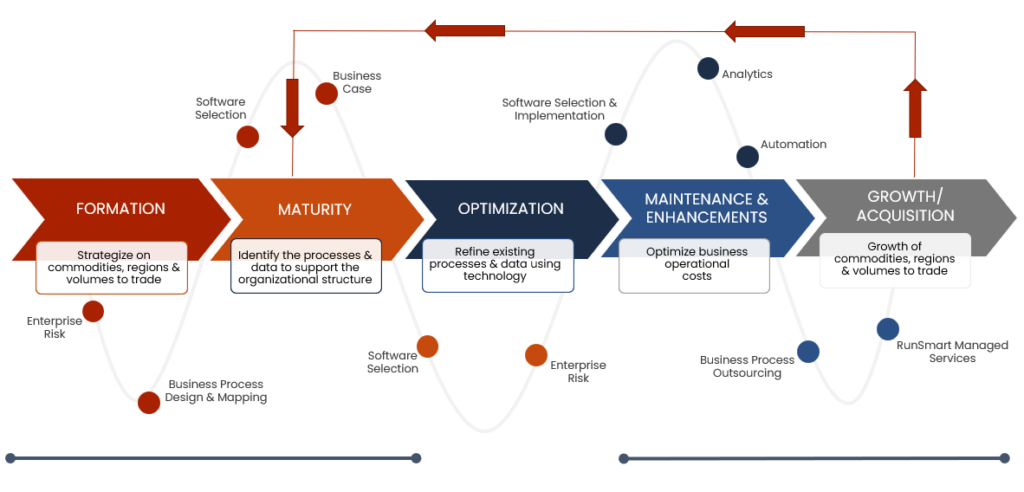Elevating Trading Operations Excellence Through Strategic Business Process Design
In today’s rapidly evolving commodity landscape, the quest for trading strategy, precision, and having the right tools at your disposal for efficiency is paramount.
Whether your organization is in its infancy, grappling with growth challenges or aiming to diversify into new industry sectors, the strategic design and foundation of your business processes are essential. In this blog, we delve into why business process design is your secret weapon in the world of commodity trading and how it can transform your operations. We will also pinpoint when it’s time for a redesign.
Significance of Business Process Design
Business Process Design is the foundation of success in Commodity Trading and Risk Operations. Its importance can be broken down into key principles that strengthen a company’s competitive position in this complex field.

Efficiency
Efficiency reigns supreme in the world of commodity trading and risk operations. The meticulous coordination of processes can mean the difference between profit and loss. With well-designed operations, you'll be able to execute trades with the strategic precision, reducing operational errors, and optimizing every crucial opportunity to enhance profitability.

Risk Management
Risk management is at the core of commodity trading, beating like a steady heart. In this dynamic world of price swings, supply chain hiccups, and global complexities, a robust strategy is essential. A well-crafted business process design blends together thorough risk evaluation, effective risk reduction, and vigilant monitoring, serving as your protective shield to spot and skillfully navigate potential dangers.

Compliance
Compliance forms the bedrock of ethical and legal stability in commodity trading. Diverse regulatory requirements, varying by region and commodity type, demand meticulous adherence. Business process design serves as a compliance compass, guiding your operations through the labyrinth of regulations and ensuring your business avoids the pitfalls of non-compliance, financial penalties, and legal entanglements.
In summary, a well-designed business process seamlessly integrates with existing systems, and workflows, while also defining how these processes interact with each other. Meticulously crafted processes foster better coordination and synergy across the organization, leading to improved overall efficiency and productivity. Additionally, it enhances visibility, providing near real-time access to information facilitating swift decision-making, and identifying any performance or compliance gaps.
When to Consider Business Process Redesign
Commodity trading organizations progress through distinct phases in their lifecycle. We have used CBOLTM as a guiding framework to gauge whether a company is in its early formation and maturity stages or experiencing significant growth, either through organic expansion into new markets or via inorganic means such as acquisitions. In both scenarios, it is imperative for companies to assess and potentially adapt their business processes, albeit for different reasons.
When a company finds itself in the formation and maturity stages, it often grapples with resource limitations. Consequently, its processes must factor in the expertise gap and the technological challenges inherent in managing complex ETRM systems.
Conversely, in the case of substantial growth, a comprehensive review of business processes becomes essential. This review should aim to establish consistency and scalability across various business segments while accommodating variances that may arise due to differences in commodities traded or the regions in which the company operates.
Navigating the transitions between these stages demands addressing distinct sets of responsibilities, risk variables, and pivotal decisions. Effective management, especially during a period of sustained expansion, is not only crucial but also entails the additional challenge of resource optimization. This is especially pertinent in the current landscape marked by constraints on both capital and human resources.
Strategic Approach to Business Process Design in Commodity Trading: Building for the Future
In the realm of commodity trading risk management, the process of designing business procedures extends beyond merely assessing the current state; it necessitates a keen understanding of the future vision. Your business processes must exhibit the resilience required to seamlessly execute that envisioned future.
Consider, for instance, the case of incorporating a robust risk governance framework into your trading operations as a future imperative. It becomes paramount to integrate these considerations into your current process design efforts. In our approach, we accomplish this by aligning with industry best practices and engaging in in-depth dialogues with pertinent stakeholders. Through this collaborative effort, we pinpoint process gaps and strategically prioritize those aligning with the company’s future vision thereby ensuring long term efficiency, scalability and flexibility in trading operations.
Below is a high level view of our approach to business process design:
Review and analysis of current state functions
Target the processes most amenable to optimization
Interview stakeholders to define process goals
Confirm current practices to industry best practices
Carry out client approved workflow optimization
Plan future-state scalability and functionality
Unlocking Success with Meticulous Business Processes: Building a Strong Foundation
By prioritizing well-crafted processes, commodity trading companies are empowered to secure their competitive edge, enhance scalability, and navigate the ever-evolving landscape. Whether as an organization you are at the inception stage or experiencing rapid growth, it’s essential to recognize that your business processes form the very foundation upon which trading operational excellence is built.
Strategic business process design serves as the key for achieving success, driving efficiency, managing trading risks, and ensuring compliance. It serves as a compass guiding organizations through diverse phases of their lifecycle, adapting to resource constraints or growth challenges.
Strategic business process design serves as the key to success, driving efficiency, managing risks, and ensuring compliance. It is a compass guiding organizations through different phases of their lifecycle, adapting to resource limitations or growth challenges.
Want to Learn More About Our Advisory Services?
Let Us Know


